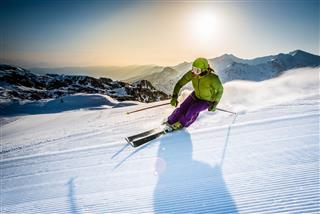
Skiing has many disciplines that defy the imagination with aerial flips and zigzag turns. The article focuses on two of the fastest events, Super-G and Downhill.
Fact
The races of Downhill alpine skiing and Super-G are decided in only one run.
Skiing has always been a favorite sport of people living near snow-clad mountains. It was used as the means of transportation before it was officially turned into a sport. The wind in your hair as you ski down a mountain slope is a rush very few get to experience. Plus the weather and the blue skies are a mood enhancer. It’s no wonder that skiing has become a popular sport.
There are 2 main types of skiing, alpine skiing and freestyle skiing. Freestyle skiing includes more speed and competition than the former, with stunts being the major reason for this popularity. But alpine skiing is a sport to watch out for in the Olympics. It’s about speed and technique. But there are other things like the equipment and the course length which also determine the race. There are five disciplines of alpine skiing; namely, Downhill, Slalom, Giant slalom, Super-G, and a combined race which has a downhill race and two slalom runs. We tell you the differences between downhill alpine skiing and Super-G and the reasons for their popularity.
Downhill skiing is a very straight-forward event with an emphasis on speed. The course for downhill skiing usually starts at the mountaintop and ends at the bottom of the slope. The pathway is usually filled with gates that you have to cross, accompanied with speed bumps like swift turns, dips and flats, and small jumps.
Equipment
The skis usually have rounded, low-profile tips. The skis have a shorter side-cut radius and are longer than those of Super-G. Ski poles can be bent easily, which helps the skier to zigzag around the curves. As in other alpine disciplines, downhill skiers wear skin-tight equipment and helmets to ensure protection against any external injury.
Super-G skiing combines the elements of downhill and giant slalom. The length of the course is shorter than in downhill where the athlete completes one run while dodging the gates that serve as obstacles. It focuses more on turning and technique with the tuck position being the most used in this race.
Equipment
The ski poles are straight and made of tough materials like metal or wood to knock the obstacles out of the path. The lengths of the skis have been reduced to 205 cm (80.7 in) for men and 200 cm (78.7 in) for women. The minimum turning radius was increased to 45 m for the 2013/2014 season. In SG races, the pads are frequently worn on the arms, shins, and knees.
While Super-G racing is considered more dangerous than downhill racing, the skiers have gotten speeds of almost 81 mph. Safety nets and padding are adopted in risky pockets of the mountain slope. While dangers abound, these sports still attract the cream of the crop from all over. If you are an extreme sport enthusiast, you can definitely try snow skiiing or cheer for your favorite in the Winter Olympics.













